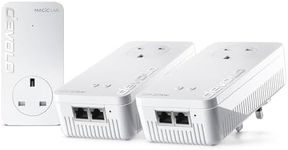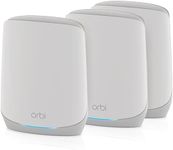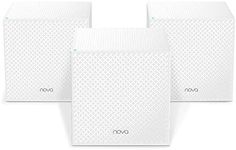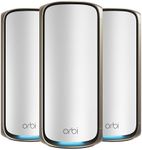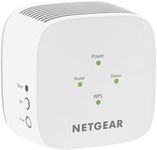Buying Guide for the Best Wifi Extenders
When choosing a WiFi extender, it's important to understand that the primary goal is to enhance the coverage of your existing WiFi network. A WiFi extender, also known as a repeater or booster, works by receiving your existing WiFi signal, amplifying it, and then transmitting the boosted signal. This can help eliminate dead zones in your home or office, ensuring a more consistent and reliable internet connection. To find the best WiFi extender for your needs, consider the size of the area you need to cover, the number of devices that will be connected, and any specific features you might require.Coverage AreaThe coverage area of a WiFi extender refers to the maximum distance over which it can effectively boost your WiFi signal. This is important because it determines how much of your home or office will receive a strong WiFi signal. Coverage areas can vary significantly, with some extenders covering up to 1,000 square feet and others extending coverage to 3,000 square feet or more. To choose the right coverage area, consider the size of the space you need to cover and any obstacles like walls or floors that might interfere with the signal. If you have a large home or office, opt for an extender with a larger coverage area.
SpeedThe speed of a WiFi extender is measured in megabits per second (Mbps) and indicates how fast data can be transmitted over the network. This is crucial for activities that require high bandwidth, such as streaming videos, online gaming, or video conferencing. WiFi extenders come in different speed categories, such as 300 Mbps, 750 Mbps, or even higher. To choose the right speed, consider your internet plan's speed and the activities you typically perform online. If you have a high-speed internet plan and engage in data-intensive activities, opt for a higher-speed extender.
Frequency BandsWiFi extenders operate on different frequency bands, typically 2.4 GHz and 5 GHz. The 2.4 GHz band offers a longer range but slower speeds, while the 5 GHz band provides faster speeds but a shorter range. Dual-band extenders can operate on both frequencies, offering a balance between speed and coverage. When choosing a frequency band, consider the layout of your space and your internet usage. If you need to cover a larger area with fewer obstacles, a 2.4 GHz band might be sufficient. For faster speeds and less interference, especially in densely populated areas, a 5 GHz band or a dual-band extender is preferable.
CompatibilityCompatibility refers to whether the WiFi extender can work with your existing router and devices. Most modern extenders are compatible with a wide range of routers, but it's important to ensure that the extender you choose supports the WiFi standards used by your router, such as 802.11n, 802.11ac, or 802.11ax. To ensure compatibility, check the specifications of both your router and the extender. If you have a newer router, look for an extender that supports the latest WiFi standards for optimal performance.
Ease of SetupEase of setup refers to how simple it is to install and configure the WiFi extender. This is important because a complicated setup process can be frustrating and time-consuming. Many extenders offer features like WPS (WiFi Protected Setup) for quick installation, or mobile apps that guide you through the setup process. When choosing an extender, consider your comfort level with technology and look for one that offers a straightforward setup process. If you're not tech-savvy, opt for an extender with user-friendly installation features.
Additional FeaturesAdditional features in a WiFi extender can enhance its functionality and convenience. These might include Ethernet ports for wired connections, beamforming technology for better signal direction, or smart signal indicators to help you find the best placement. Some extenders also offer mesh networking capabilities, allowing you to create a seamless network with multiple extenders. When considering additional features, think about your specific needs and how these features might improve your WiFi experience. For example, if you have devices that require a wired connection, look for an extender with Ethernet ports.
